light NISSAN GT-R 2022 Owners Manual
[x] Cancel search | Manufacturer: NISSAN, Model Year: 2022, Model line: GT-R, Model: NISSAN GT-R 2022Pages: 1808, PDF Size: 4.88 MB
Page 2 of 1808
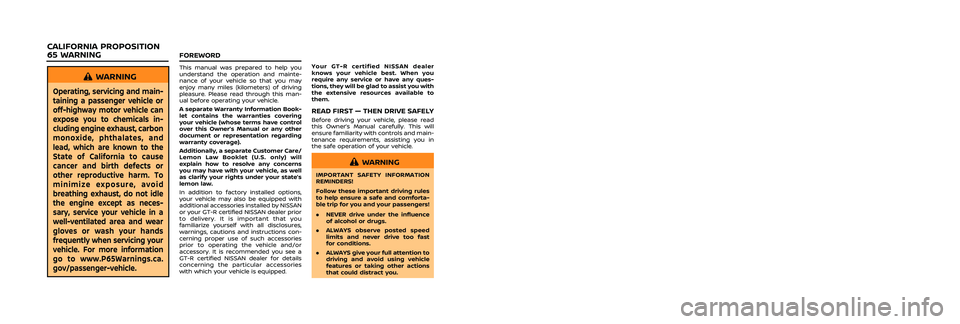
OPENING AND CLOSING THE
TRUNKWhen opening the trunk, first unlock it
then lift up the trunk lid so that it is fully
open.
When closing the trunk, lower the trunk
lid and press it until it is securely locked in
place. The strap
(except for carbon
trunk lid models) or the handle
(for
carbon trunk lid models) can be used
when the trunk lid is dirty.
NOTICE
. Open and close the trunk without
grasping the rear spoiler. Grasp-
ing the rear spoiler to open or
close the trunk may damage the
spoiler.
. Do not leave the key inside the
trunk.
NOTE:
. To prevent the Intelligent Key from
being accidentally locked in the
trunk, lockout protection is
equipped with the Intelligent Key
system. When the trunk lid is closed
with the Intelligent Key inside the
trunk, the outside buzzer will sound and the trunk will open.
. The trunk of this vehicle is slightly
more difficult to close than an or-
dinary vehicle (particularly when the
vehicle is new). This is because the
trunk rigidity has been increased to
handle the high load on the rear
spoiler during vehicle operation.
This does not indicate that there is
a malfunction. Check that the trunk
is securely locked.
EMERGENCY TRUNK LID RELEASE
WARNING
Closely supervise children when they
are around cars to prevent them
from playing and becoming locked
in the trunk where they could be
seriously injured. Keep the car
locked, with the trunk lid securely
latched, when not in use, and pre-
vent children’s access to Intelligent
Keys.
The emergency trunk lid release mechan-
Page 3 of 1808
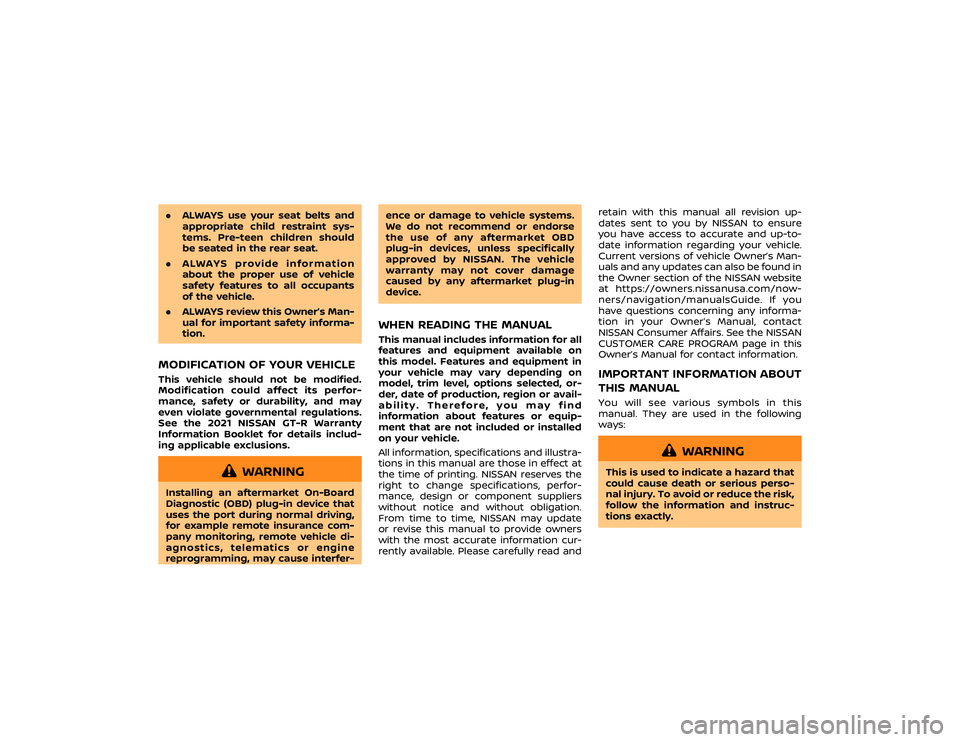
until the lock
releases and push up on the trunk lid.
The release lever is made of a material
that glows in the dark after a brief
exposure to ambient light.
The handle is located on the back of the
trunk lid as illustrated.
2. Insert the mechanical key into the
emergency trunk lid opener and turn
it clockwise until it stops.
NOTE:
Because the trunk rigidity has been
increased to handle the high load on
the rear spoiler during vehicle opera-
tion, more force is required to operate
the mechanical key (particularly when
the vehicle is new). Be sure to turn the
key clockwise until it stops.Pre-driving checks and adjustments
3-23
Page 4 of 1808
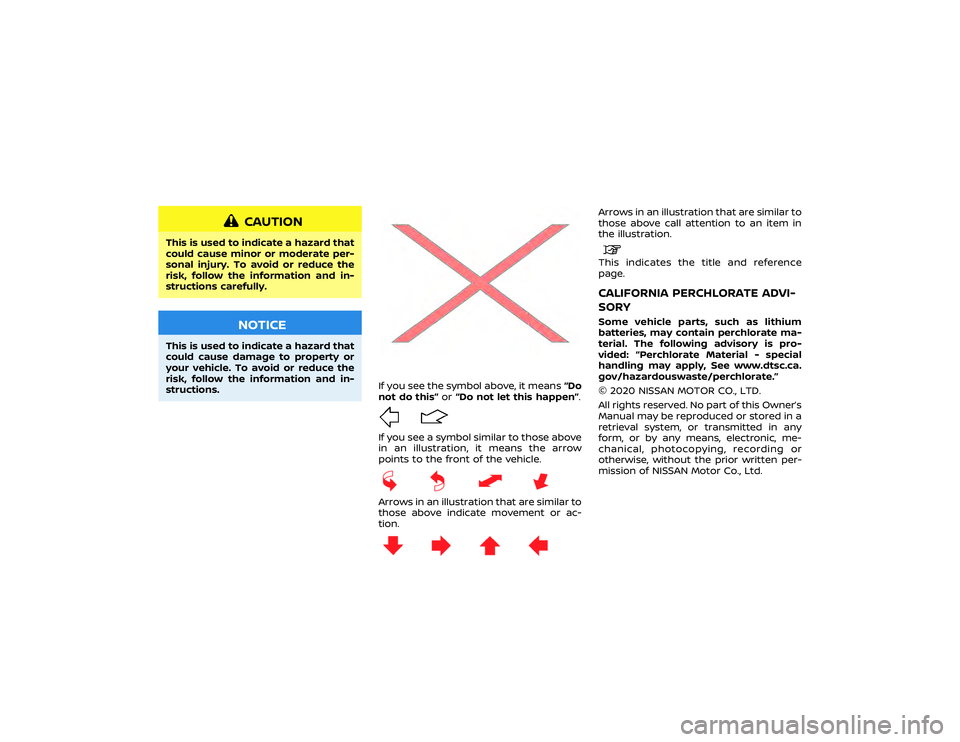
NOTICE
.If fuel is spilled on the vehicle
body, flush it away with water to
avoid paint damage.
. Insert the cap straight into the
fuel-filler tube, then tighten until
the fuel-filler cap clicks. Failure to tighten the fuel-filler cap properly
may cause the
Malfunction
Indicator Light (MIL) to illuminate.
If the
light illuminates be-
cause the fuel-filler cap is loose
or missing, tighten or install the
cap and continue to drive the
vehicle. The
light should turn
off after a few driving trips. If the
light does not turn off after a
few driving trips, it is recom-
mended you have the vehicle
inspected by a GT-R certified
NISSAN dealer.
(“Malfunction Indicator Light
(MIL)” page 2-32)
. This vehicle includes a system
that can supply fuel even during
high-G (gravity) turns. The fuel
tank pressure is higher when the
vehicle is hot. If the vehicle is
refueled when the vehicle is hot,
the fuel pump may automatically
shut off before the tank is full.
This does not indicate that there
is a malfunction.
FUEL-FILLER DOOR
Page 7 of 1808
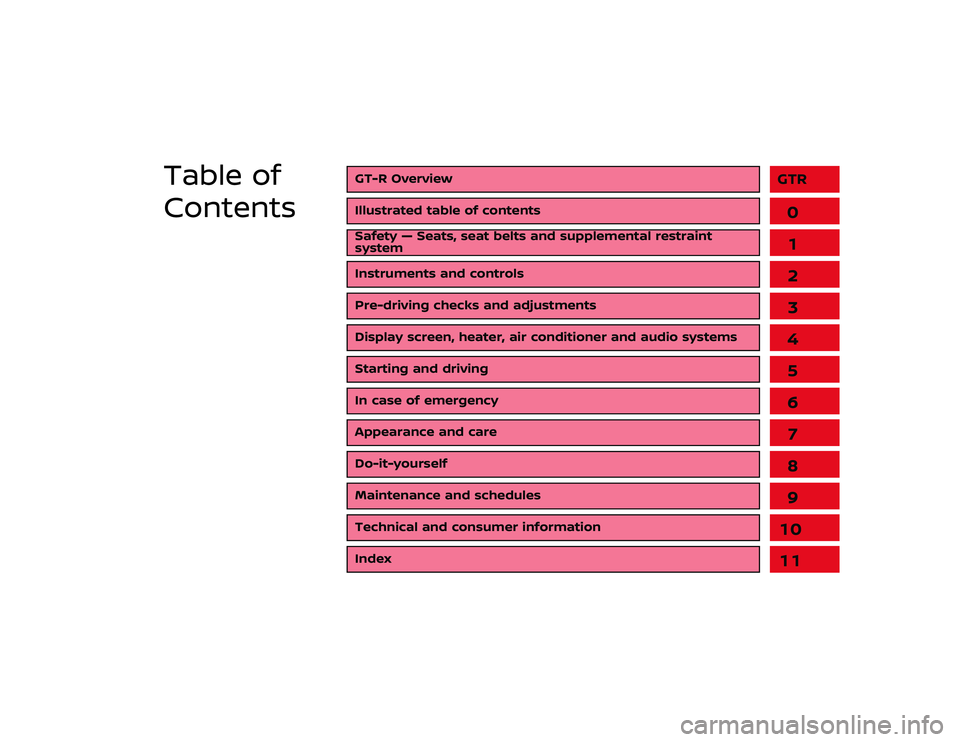
down
.
2. Move the steering wheel forward/ backward
and stop it in an appro-
priate position.
3. Lift up lever
to lock the steering
wheel in position
.
Lower the sun visor to block sunlight
coming from the forward direction.
To block sunlight coming from the side,
lower the sun visor, then unclip it from the
hook and move it to the side.
will illuminate and
excessive glare from the headlights of the
vehicle behind you will be reduced.
Push the
Page 18 of 1808
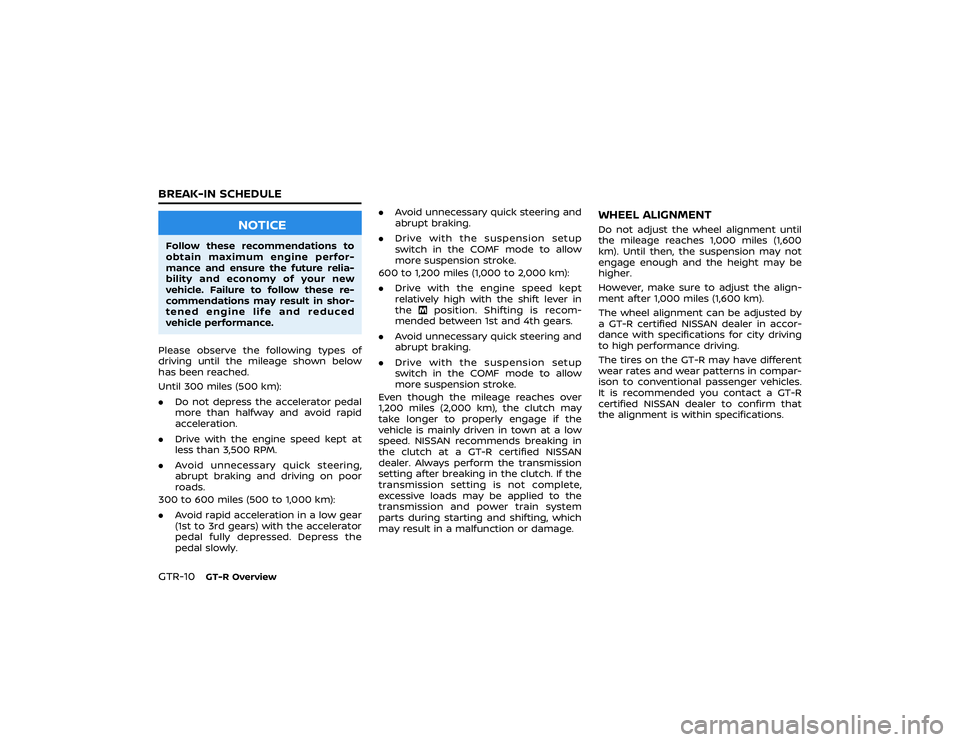
is used.
. Objects in the RearView Monitor
will appear visually opposite
compared to when viewed in the
rearview and outside mirrors.
. Use the displayed lines as a re-
ference. The lines are highly af-
fected by the number of
occupants, fuel level, vehicle po-
sition, road conditions and road
grade.
. Make sure that the trunk lid is
securely closed when backing up.
. Do not put anything on the rear-
view camera. The rearview cam-
era is installed above the license
plate.
. When washing the vehicle with
high-pressure water, be sure not
to spray it around the camera.
Otherwise, water may enter the
camera unit causing water con-
densation on the lens, a malfunc-
tion, fire or an electric shock.
. Do not strike the camera. It is a
precision instrument. Otherwise,
it may malfunction or cause da-
mage resulting in a fire or an
electric shock. The following are operating limitations
and do not represent a system malfunc-
tion:
.
When the temperature is extremely
high or low, the screen may not clearly
display objects.
. When strong light is directly coming
on the camera, objects may not be
displayed clearly.
. Vertical lines may be seen in objects
on the screen. This is due to strong
reflected light from the bumper.
. The screen may flicker under fluores-
cent light.
. The colors of objects on the RearView
Monitor may differ somewhat from
the actual color of objects.
. Objects on the monitor may not be
clear in a dark environment.
. There may be a delay when switching
to the RearView Monitor screen.
. If dirt, rain or snow accumulates on
the camera, the RearView Monitor
may not display objects clearly. Clean
the camera.
. Do not use wax on the camera win-
dow. Wipe off any wax with a clean
cloth dampened with mild detergent
diluted with water.
SYSTEM MAINTENANCE
CAUTION
.Do not use alcohol, benzine or
thinner to clean the camera. This
will cause discoloration. To clean
the camera, wipe with a cloth
dampened with diluted mild
cleaning agent and then wipe
with a dry cloth.
. Do not damage the camera as the
monitor screen may be adversely
affected.
Page 22 of 1808

front defroster button
on. (The indicator light on the button
will come on.)
2. Turn the temperature control dial on the driver
Page 28 of 1808

, position the two vehicles (
and
) to bring their batteries into
close proximity to each other. Do not
allow the two vehicles to touch.
2. Apply parking brake. Move the shift lever to the
position. Switch off all unnecessary electrical systems (light,
heater, air conditioner, etc.).
3. Remove the battery cover. Cover the battery with a firmly wrung out moist
cloth to reduce explosion hazard.
4. Connect jumper cables in the se- quence as illustrated (
?
?
CAUTION
.Always connect positive (+) to
positive (+) and negative (−) to
body ground (as illustrated), not
to the battery.
. Make sure that the jumper cables
do not touch moving parts in the
engine compartment and that
clamps do not contact any other
metal.
5. Start the engine of the booster vehicle
and let it run for a few minutes.
6. Keep the engine speed of the booster
In case of emergency
6-7
Page 68 of 1808

WARNING
Do not attempt to top off the fuel
tank after the fuel pump nozzle
shuts off automatically. Continued
refueling may cause fuel overflow,
resulting in fuel spray and possibly a
fire. The fuel tank is full at the first
automatic shutoff.
To maximize vehicle performance, the
fuel tank is located as low as possible to
lower the vehicle center of gravity. The
tank is also divided into two parts. This
fuel tank design causes higher pressures
inside the tank than other vehicles so fuel
spillage is possible by trying to top off the
fuel tank after automatic shutoff.
The fuel tank pressure is higher when the
vehicle is hot, especially if the tank is more
than half full. If the cap is opened when
the vehicle is hot, it may cause fuel spray
and there may be a hissing noise. Open
the cap slowly, releasing the pressure
from the tank gradually. Also, if the
vehicle is refueled when the vehicle is
hot, the fuel pump may automatically
shut off before the tank is full. This does
not indicate that there is a malfunction. Refuel slowly or refuel after the vehicle
has cooled.
GASOLINE SMELLThe fuel temperature is higher when the
vehicle is hot. This may cause a gasoline
smell from the vehicle. This does not
indicate that there is a malfunction. The
smell will go away when the fuel tem-
perature has cooled.OUTSIDE TEMPERATURE DISPLAY
INDICATES HIGHER TEMPERATUREHeat from the engine compartment, ra-
diator and intercoolers can affect the
outside temperature display. The outside
temperature display may indicate a high-
er than actual temperature while driving
or stopped. This is normal.IDLE SPEED IS NOT STEADYThe idle speed may not be steady when
the engine compartment is extremely
hot. This is normal. The engine speed will
be steady when the engine cools down.
In this case, the Malfunction Indicator
Light (MIL) may come on. After a few
driving trips, the MIL should turn off. If the
light remains on after a few driving trips, it
is recommended you have the vehicle
inspected by a GT-R certified NISSAN
dealer.
GT-R Overview
GTR-25
GT-R SPECIFIC VEHICLE CHARACTERISTICS
Page 72 of 1808

Rattles from brake pads and creaks
during braking
The high performance brake system of
vehicles equipped with the NCCB (NISSAN
Carbon Ceramic Brake) has more clear-
ance between its brake pad and brake
caliper than regular vehicles, and it uses a
large brake pad to ensure stable brakingperformance under a wide range of driv-
ing conditions such as extremely high
temperature areas or low temperature
areas like snow-covered roads. Accord-
ingly, you may hear light rattles from the
brake pad area when driving over a step,
which is not a malfunction. In addition,
you will hear creaks because of the
characteristics of the material for the disc
rotor. These creaks reduce with time and
wear.
Never park your vehicle for a long time
with the brake system wet.
The materials used for the brake disc
rotor and brake pads for specified NCCB
(NISSAN Carbon Ceramic Brake) are dif-
ferent from those used for the standard
brake system in GT-R. The rotor and pads
will be protected from adhesion caused
by rusting. However, never park your
vehicle for a long time with the brake
system wet. This helps maintain the brake
disc rotor and brake pads for a long time
and prevents an influence on the material
composition of the carbon ceramic rotor
and deterioration in the joint of brake disc
rotor’s full floating structure. Especially
during winter, be sure to park your vehicle
with the brake disc rotor and pads dry to
prevent them from being frozen and
damaged in below freezing temperature
conditions. The carbon ceramic brake forGT-R includes air bubbles in the rotor and
pads. Note that leaving them in the wet
condition tends to cause adhesion due to
freezing.
.
A screeching noise may be heard
when the brake pedal is depressed:
— When driving the vehicle for the first
time in the morning,
— After leaving the vehicle parked for extended periods of time, or
— When the vehicle is damp following rain showers or washing the vehi-
cle.
These sounds are normal. The noise is
caused when the brake pads absorb
moisture, and the noise stops after
the brake is applied several times.
. A screeching noise may also be heard
when the brake pedal is depressed:
— When repeatedly applying gentle
braking, especially on a curve at a
low speed, or
— When the brake rotors have circular scores with the brake temperature
high.
. The NCCB (NISSAN Carbon Ceramic
Brake) causes more screeching noise
in cold weather conditions than in
normal weather conditions.
GT-R Overview
GTR-29
Page 78 of 1808

0 Illustrated table of contentsSeats, seat belts and Supplemental Restraint
System (SRS).................................................................................... 0-2
Front ................................................................................................ 0-2
Rear .................................................................................................. 0-3
Exterior front ................................................................................... 0-4
Exterior rear ..................................................................................... 0-6 Passenger compartment ...................................................... 0-7
Cockpit ................................................................................................ 0-8
Instrument panel ........................................................................ 0-9
Meters and gauges ................................................................ 0-10
Engine compartment ........................................................... 0-11
Warning and indicator lights .......................................... 0-12